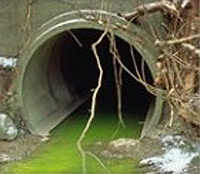Water pollution

Water pollution is a large set of adverse effects upon water bodies (lakes, rivers, oceans, groundwater) caused by human activities. Although natural phenomena such as volcanoes, storms, earthquakes etc. also cause major changes in water chemistry and the ecological status of water, these are not deemed to be pollution. Water pollution has many causes and characteristics. Humans and other farmed organisms produce bodily wastes which enter rivers, lakes, oceans and other surface waters. These wastes increase the solids suspended in the water (turbidity), they can increase the concentration of bacteria and viruses leading to potential health impacts. Increases in nutrient loading may lead to eutrophication). Organic wastes such as sewage and farm waste impose high oxygen demands on the receiving water leading to oxygen depletion with potentially severe impacts on the whole eco-system. Industries discharge a variety of pollutants in their wastewater including heavy metals, organic toxins, oils, nutrients, and solids. Discharges can also have thermal effects, especially those form power stations, and these too reduce the available oxygen. Silt-bearing runoff from many activities including construction sites , forestry and farms can inhibit the penetration of sunlight through the water column restricting photosynthesis and causing blanketing of the lake or river bed which in turns damages the ecology.
Pollutants in water include of a wide spectrum of chemicals, pathogens, and physical chemistry or sensory changes. Many of the chemical substances are toxic or even carcinogenic. Pathogens can obviously induce disease in either human or animal hosts. Alteration of water's physical chemistry include acidity, conductivity and temperature. excessive nutrient loading (eutrophication). Even many of the municipal water supplies in developed countries can present health risks. In the U.S.in 1972 stringent federal laws were enacted setting specific discharge limitations.
Water pollution is a serious problem in the global context. It has been suggested that it is the leading worldwide cause of death and disease[1][2], and that it accounts for the deaths of more than 14,000 people dailyCite error: A <ref> tag is missing the closing </ref> (see the help page).
- ^ Pink, Daniel H. (April 19, 2006). "Investing in Tomorrow's Liquid Gold". Yahoo.
- ^ West, Larry (March 26, 2006). "World Water Day: A Billion People Worldwide Lack Safe Drinking Water". About.
